Archive for April 2013
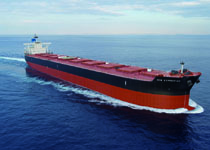 Mitsui Engineering & Shipbuilding Co., Ltd. (MES) completed and delivered a 174,600 dwt type bulk carrier, MV “NEW EXPEDITION” at its Chiba Works on February 1st, 2013 to Salute Maritime S.A., Panama.
Mitsui Engineering & Shipbuilding Co., Ltd. (MES) completed and delivered a 174,600 dwt type bulk carrier, MV “NEW EXPEDITION” at its Chiba Works on February 1st, 2013 to Salute Maritime S.A., Panama.
This ship is a Cape-size Bulk Carrier of Dunkerque-max Type(*). It enables effective cargo handling, easy maintenance of cargo holds and structural safety by adopting a double-side skin to cargo holds construction.
(*) Cape-size Bulk Carrier of Dunkerque-max type: A common name for the Cape-size Bulk Carrier accommodated to the restriction of the port of Dunkerque, France.
Principal Particulars
Length overall
|
292.00 m
|
Length (between perpendiculars)
|
282.00 m
|
Breadth (molded)
|
44.98 m
|
Depth (molded)
|
24.70 m
|
Gross Tonnage
|
92,382
|
Deadweight
|
176,387 metric tons
|
Main Engine
|
MITSUI-MAN B&W Diesel Engine 6S70MC-C x1set
|
Maximum Continuous Output
|
18,660 kW x 91rpm
|
Service Speed
|
15.5 knots
|
Complement
|
27 persons
|
Classification Society
|
NK
|
Flag
|
Panama
|
Date of Delivery
|
February 1st, 2013
|
-
In spite of cargo holds bounded by a double-side skin according to SOLAS, the cargo capacity of the ship is equivalent to that of conventional Cape-size bulk carriers with holds bounded by a single-side skin.
-
The vessel is designed in accordance with IACS Common Structural Rules. As a result, structural safety and operational flexibility are improved.
-
Suitable arrangement of means of access required by SOLAS enables safe and effective inspection in cargo holds and ballast tanks.
-
Improvement of safety has been achieved by installation of a forecastle and by application of new requirements concerning reserve buoyancy to the ship.
-
Main Engine of the ship is MITSUI-MAN B&W Diesel Engine 6S70MC-C, which satisfies IMO Environment Standards for Exhaust Gas and achieves improvement of fuel saving by optimum matching at normal service output. An electronic controlled cylinder oiling system is applied to the main engine achieving operational cost saving.
-
Ballasting and de-ballasting work can be efficiently made by separation of topside tank and bottom side tank.
-
Ballast Water Treatment System is installed on board for protection of marine environment.
-
IMO PSPC(Performance Standard for Protective Coatings) is applied for water ballast tanks to improve the quality and effectiveness of the coatings.
三井造船、二重船側構造を採用した17万4600重量トン型ばら積み貨物運搬船を引き渡し
2013年2月4日(月)
三井造船は、千葉事業所で建造していたパナマのサリュート・マリタイム向け17万4600重量トン型ばら積み貨物運搬船「ニュー・エクスペディション」が完成し、同事業所で引き渡した。
新造船は、貨物艙に二重船側構造を採用することにより、荷役効率化、貨物艙内のメンテナンス性、構造安全性の向上を図ったダンケルクマックス型ケープサイズバルカーの11番船となる。
SOLAS条約の二重船側構造要件を満たした構造でありながら、構造配置を工夫することで、従来の単船側構造船並みの貨物艙容積を確保した。新しい規則である国際船級協会連合共通構造規則も適用することで、オペレーションの自由度と構造安全性向上の両立を図った。
SOLAS条約に基づいた通行設備を貨物艙内に設置することで、安全で効率の良い点検が可能。船首楼の設置と船首部予備浮力に関する新規則への対応で、安全性の向上を図った。MARPOL条約の燃料油タンク保護規則に対応し、環境保護にも配慮している。
主機関にはIMO排ガス環境基準を満たした三井-MAN B&W6S70MC-C型を装備する。航海速力は15.5ノット。常用出力で最適なマッチングとすることで、低燃費化を図った。また、電子制御式シリンダ注油システムを採用し、運航コスト低減を図っている。
海洋環境保護のため、バラスト水処理装置を搭載する。バラストタンク内面塗装にはIMO新塗装性能基準を適用し、塗装品質と防食性能の向上を図った。
全長は292メートル、載貨重量トン数は17万6387メトリックトン。最大搭載人数は27人。

Shrimp exports from Pananam have begun to recover, but are still surpassed by other seafood ítems such as the spiny lobster, yellow-fin tuna and salmon. which show continued increases in exports with better prices in international markets.
The main monthly economic indicators of the Comptroller General’s Office show that during the eight-month period of Jan.-Oct. 2012, the volumen of shrimp exports grew by 7.5%, whereas frozen lobster rose by 15%, salmon 44.2%, frozen yellow-fin tuna 84.3%, fresh yellow-fin tuna 80.6%, and salted fish by 86.5%. The reports shows that even though the fishing sector as a whole continued to decline in sales (-5.3%) last year, it is better than the year before (2011) when their total FOB value fell by 41.1%.
The fishing sector represented 14.0% of Panamaniana exports during the same period last year, compared to industrial products which were 43.3%, agriculture/livestock 27.9% and agrobusiness 14.9% of total exports.
The president of the Association of Seafood Exports of Panama (APEXMAR), Valerio de Sanctis, said that it is encouraging to see the recovery of exports from the fishing sector, which is the result of innovations and adjustments mad by companies to comply with international regulations regarding fishing aparatus and resource conservation. Nonetheless, the Eurpean Union restricts imports of Panamanian seafood products due to Panama being considered a country that allows illegal fishing with little supervision of the international fishing boats with Panamanian flag. This impedes local exporters from placing their products in the European market. “We hope that the government complies with the supervisión of international fishing vessels with Panamanian flag and that the E.U. will allow Panamanian exports to Europe again,” Sanchis stated.
For his part, the Director of Foreign Trade of the Ministry of Commerce, Ricardo Barnet, said that climate change, overfishing, and prohibition of the use of certain fishing apparatus has affected fish catch, but that shrimp farming has helped in the recovery of shrimp exports. Also, that fishing farming in ocean cages is showing great results, such as raising Cobia to export to the United States. (see related post here) He stated that new niches for Panamanian seafood are openning in Taiwan and South Korea (who have FTAs with Panama). Barret added that various Caribbean countries, such as Aruba, San Martin and Caiman are very interested in obtaining Panamanian seafood products to supply the great demand of tourists visiting their islands. Also that conversations are underway with important Korean importers to expand the presence of Panamanian products in South Korea.
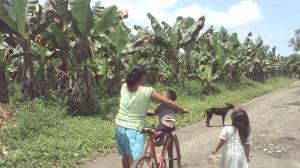
“I believe that Panama’s capacity for growth is spectacular, but it is not convincing because the income is going to one group,” said Enrique Iglesias, the former president of the InterAmerican Development Bank (IDB), in his speech at the ALADI (Latin American Integration Association) Fórum during the 31st Expocomer being held in Panama.
He praised the competitive advantages Panama has for its Canal and financial center, but at the same time he was emphatic in pointing out that countries with high growth rates also have high rates of inequality, which cannot be sustained because in the long run it will affect peace in the society.
He stated that Panama’s great challenge is to end this inequality because these circumstances could give rise to movements by people who aren’t part of this economic growth and do not see their quality of life improving. He emphasized that a great gap is seen in education where persons with higher income have a better quality of education while the rest of the population do not have access to good education.
His remarks were seconded by the Secretary General of ALADI, Carlos Alvarez, who said that Latin America is growing without social justice, which is evident in the unemployment, informal employment, poverty, and the lack of basic services and marginaliztion with which a large part of the population lives, while at the same time, there is a small group that enjoys a good quality of life with access to the latest technologies. He commented that Latin American societies are very unequal. Even though they have been able to reduce exreme poverty and indigence, the great majority still live in poverty. Therefore, there is an urgent need to promote human development and a fair distribution of wealth with basic services and better education for the larger population so they can have greater access to development. In this sense, he stated that integration (of Latin America) plays a very important role in promoting a better living standard for its citizens.
TOKYO-Mitsui O.S.K. Lines, Ltd. today announced that the company acquired approval in concept for installation of a packaged container ballast water treatment system that can fit in a vessel’s cargo hold(*). The new technology offers much faster installation time on an existing vessel, compared to systems installed in the vessel’s engine room.
The commercially available BWTS is packaged in a 40-foot container (about 12m long) with electric equipment. Ease of maintenance and accessibility is considered for this containerized design.
Characteristics of the container-type ballast water treatment system
-
Shorten the work required such for preliminary inspection because the system is containerized, allowing for a great reduction of detailed pipe fitting and adjustment at the installation stage.
-
Installation time is reduced by an estimated seven days, compared to installing a system in the engine room.
-
Effective solution for vessels with limited engine room space.
Ballast water discharged while loading/discharging cargo carries marine organisms around the world and can have a negative impact on marine ecosystems and biodiversity. This has become a subject of global concern since the late 1980s. Accordingly, the International Maritime Organization (IMO) adopted the Ballast Water Management Convention in February 2004, and its ratification is under way.
(*)Concept Approval of Installation for Packaged Container Ballast Water Treatment System in Cargo Hold: Approved by third-party accredited Nippon Kaiji Kyokai (ClassNK) for installation in conformity with the rules and regulations.

Left: A container-type ballast water treatment system installed. Right: Sketch of the system, packaged in a 40-foot container.
「コンテナ型バラスト水処理装置」の初号装置
商船三井と三菱重工業が共同開発した「コンテナ型バラスト水処理装置」の初号装置がこのほど完成し、5日、横浜港本牧埠頭の横浜国際コンテナターミナル(YICT)内で報道関係者に公開された。
バラスト水処理装置をコンテナ船のホールド(船倉)に設置するその基本設計について一般財団法人日本海事協会から基本承認を国内で初めて取得
商船三井は、三菱重工業㈱と共同で、バラスト水処理装置をコンテナ内に収納してコンテナ船のホールド(船倉)に設置する技術を開発し、その基本設計について一般財団法人日本海事協会から基本承認※を、 国内で初めて取得した。これにより、既存船舶にバラスト水処理装置を設置する際、機関室に搭載する手法に比べ工期を大幅に短縮できる。
コンテナ型バラスト水処理装置は、40フィートコンテナ内に必要な機器をパッケージングしたもので、限られた空間を有効に使って、メンテナンスを施しやすいように配慮された設計となっている。
当社が保有する8,100個積みコンテナ船「MOL COMPETENCE」に、40フィートコンテナ型の初号装置を搭載して実証運用を行うべく、水処理能力750m3/ hの装置を設置するための詳細設計作業に着手した。
●コンテナ型バラスト水処理装置の特長
① 装置はコンテナ化されているため、事前調査などに要する作業を短縮でき、工事段階において、細かな配管調整などを大幅に減らすことができる。
② 事前の試算では、機関室に設置する場合に比べ7日程度の工期短縮を見込む。
③ 機関室に関連機器・配管を搭載するスペースの余裕がない船舶では極めて有効。 (記事はこちら)

The Largest Deadweight / Cargo Hold Capacity with Box-Shaped Cargo Holds
Mitsui Engineering & Shipbuilding Co., Ltd. completed and delivered a 72,800 dwt type Open Hatch Jib Crane General Cargo Carrier MV “FINCH ARROW” at its Chiba Works to 311 RAINBOW SHIPPING S.A., Panama on March 27, 2013. This is the 2nd vessel of its series which has a large cargo hold capacity of more than 86,600 m3 with 8 box-shaped cargo holds. (original article)
Principal Particulars
| Length overall |
210.00 m |
| Length (between perpendiculars) |
202.00 m |
| Breadth (molded) |
36.00 m |
| Depth (molded) |
20.20 m |
| Gross Tonnage |
46,295 |
| Deadweight |
72,914 metric tons |
| Main Engine |
MITSUI-MAN B&W Diesel Engine 5S60ME-C8(Mark8) 1set |
| Maximum Continuous Output |
9,450 kW x 89rpm |
| Service Speed |
14.5 knots |
| Complement |
30 persons |
| Classification Society |
NK |
| Flag |
Panama |
| Date of Delivery |
March 27, 2013 |
三井造船、世界最大級のオープンハッチ型一般貨物運搬船「フィンチ・アロー」を引き渡し
2013年3月27日
三井造船は、千葉事業所で建造したパナマ国311レインボウ・シッピング向け7万2800重量トン型オープンハッチ型一般貨物運搬船「フィンチ・アロー」を竣工、3月27日に同事業所で引き渡した。新造船は、8万6600平方メートルを超える大容積貨物艙を持つ7万2800重量トン型のオープンハッチ型一般貨物運搬船で、同型船シリーズとして2隻目の竣工となる。
ボックス形状の8つのホールド(貨物艙)を持ち、船自身の荷役設備として4基のジブクレーンを装備した世界最大級のオープンハッチ型一般貨物運搬船。6つのホールドにはチェーン駆動を持つピギーバックタイプハッチカバーを採用しており、大きなハッチ開口面積を確保している。 ハッチコーナー部の構造を工夫することで、突起物の無い大きなハッチ開口と信頼性の高い貨物倉構造を実現した。 貨物艙内に突起物が無く、貨物艙除湿装置を持つため、パルプ・紙製品の輸送にも適している。ハッチカバー上にコンテナ固縛金物と材木用スタンションソケットなどを装備し、コンテナや材木輸送も可能。舵に省エネ装置を装備することで、高い推進効率を実現した。主機関には、コンパクト・高出力でMARPOL NOx排出規制を満たした電子制御エンジン三井-MAN B&W 5S60ME-C8型を搭載する。バウスラスタと高揚力舵を装備し、港内での操船性にも優れている。
バラスト水管理条約の発効前だが、バラスト水処理装置を搭載して海洋環境の保護に配慮している。
By Ens. Ian McConnaughey, USS Gary Public Affairs (Original article)
SANTA ANA, Panama – Crewmembers of guided missile frigate USS Gary (FFG 51) cleaned and painted a local Youth Outreach Center in a recent port visit just before the holidays as part of a Community Relations project Dec 21.
The building was originally owned by the Red Cross but was purchased by the city and later given to the Youth Outreach Center. Gary sailors were able to clear brush, paint the interior and clean the exterior of the building while also preparing a parking lot that will later become a children’s playground.
“When we arrived we expected to do a lot of painting, so we brought a lot of paint. As it turned out, we cleaned a lot, took out trash, and only painted a little bit at the end,” said Personnel Specialist Petty Officer Second Class Jayson Velasquez. “What I liked about it was that this wasn’t just about the Navy or Gary, but the kids were involved, and cleaned and painted right alongside us. This was my first time doing this kind of project, but I would definitely do it again.”
After their hard work, Gary’s crew was treated to a traditional Panamanian lunch with a (chicken) soup called “sancocho”. Gary’s Command Senior Chief, Pablo Rosado had this to say afterward:
“It was a humbling experience for all the participants to see how much we can help a community plagued by poverty and crime. It’s nice that there are places these kids can go to escape that, and I’m glad we could be a part of this. It was a great opportunity. We would love to do it again.”
Gary is homeported in San Diego, and is currently deployed to Central and South America and the Caribbean in support of Operation Martillo and U.S. 4th Fleet’s mission, Southern Seas 2012.
アメリカ海軍、パナマのユースセンターの清掃や塗装などの奉仕活動 2013年1月13日
2013年1月12日のアメリカ合衆国海軍広報部の発表によると、誘導ミサイルフリゲート艦、USSギャリー(FFG 51)の乗組員達が、地域社会との関係改善プロジェクトの一環として、パナマの地域ユース普及活動センターに対して奉仕活動を行った。この建物は元々赤十字が所有していたが、地元自治体によって購入された後、ユース普及活動センターとして利用されている。
海軍は内装の塗装や建物の外装の掃除、そして後に運動場として利用される駐車場の準備などをした。ギャリーの乗組員達は「サン・コチョ」と呼ばれるパナマの伝統的なスープ付きの昼食のもてなしを受けた。
参加海軍の母港はカリフォルニア州のサンディエゴで、現在オペレーション・マルティロとUS第4艦隊のミッションをサポートするために中央アメリカ及び南アメリカとカリブ海方面に派遣されている。
オペレーション・マルティロは、アメリカを始めヨーロッパ、西側諸国の協力の下、中央アメリカ沿岸の不法往来ルートの監視を行っている。
この共同オペレーションには、ベリーズ、カナダ、コロンビア、コスタリカ、エルサルバドル、フランス、グァテマラ、ホンジュラス、オランダ、ニカラグア、パナマ、スペイン、イングランド、アメリカ合衆国の14か国が参加している。 (記事はこちら)


Panama is preparing to raise transgenic (genetically modified) Atlantic salmon in the cold waters of Chiriquí highlands. Rainbow trout has been farmed and exported from this same area for decades, and it is for this reason that this location was chosen by Agua Bounty Technologies for raising its AquAdvantage® Salmon. See their webpage here..
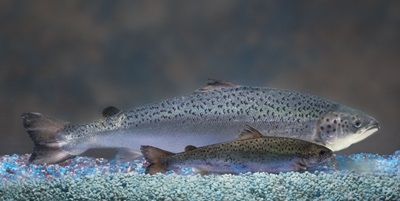
The following is an article in “Capital Financiero” by Darsy Santamaría Vega (original article here)
Aqua Bounty Tecnology está lista para la producción de esta especie en Boqueté y para su exportación a EE.UU. y Canadá
Panamá contempla desarrollar una nueva industria acuícola en la zona montañosa de aguas frías de la provincia de Chiriquí mediante la producción comercial de salmón del Atlántico AquAdvantage, el primer animal transgénico que sería aprobado para el consumo humano por la Agencia de Drogas y Alimentos de Estados Unidos (FDA, por sus siglas en inglés) con lo que se iniciarían las exportaciones hacia ese país y Canadá.
Desde hace muchos años diversos cultivos transgénicos de origen vegetal son ampliamente utilizados a nivel global en dietas de animales y también son directamente aprovechados por el hombre, pero hasta ahora no se ha aprobado el consumo humano de ningún animal modificado genéticamente.
Este proyecto desarrollado por la empresa Aqua Bounty Technologies de Massachusetts ha pasado por un proceso de aprobación del salmón AquAdvantage marca registrada por la citada empresa, el que ya se extiende por 20 años a un costo de $60 millones, cumpliendo con todas las etapas requeridas por la FDA, encontrándose a unos pasos de recibir el visto bueno para el consumo humano, lo que daría pie a los cultivos comerciales inicialmente en Panamá y su mercadeo en Estados Unidos (EE.UU.) y Canadá.
Los análisis realizados al salmón del Atlántico AquAdvantage han demostrado que la construcción genética y su forma integrada en el salmón, es segura para los peces, para los consumidores de los peces y para el medio ambiente.
El salmón del Atlántico AquAdvantage ha sido modificado genéticamente mediante la implantación de un gen de la hormona de crecimiento del salmón del Pacífico Chinook y un interruptor genético de otra especie de pez marino de agua fría el “Ocean Spout”, permitiendo al gen trasplantado permanecer continuamente activo.
El salmón del Atlántico AquAdvantage puede alcanzar el peso de mercado en tan sólo la mitad del tiempo requerido por otros salmones del Atlántico cultivados, afirman directivos de Aqua Bounty, creciendo sin perder su calidad ni su sabor, sin involucrar proteínas ni hormonas artificiales, ni incremento del nivel de hormonas, siendo nutricionalmente y químicamente idéntico a un salmón de cultivo no-transgénico.
La tecnología de producción comercial ha sido desarrollada en los últimos cinco años mediante numerosos ensayos experimentales en una finca de las tierras altas de Chiriquí dedicada al cultivo de las truchas, sitio que cuenta con aguas dulces prístinas de la temperatura requerida por la especie. A diferencia del salmón convencional, no será criado en jaulas en aguas frías marinas como ocurre en Chile y diversos países europeos, hecho que igualmente no altera su calidad ni su sabor.
El vicepresidente de mercadeo de Aqua Bounty Technologies, Henry C. Clifford, confirmó que se encuentran a la espera de la autorización por parte de la FDA, lo que permitirá la exportación de los “salmones panameños” a Estados Unidos y su consumo allá, destacando que Panamá tiene un potencial comercial enorme para la producción de salmones del Atlántico AquAdvantage dado la abundancia de agua con una temperatura alrededor de los 16 grados centígrados que manan en grandes torrentes en numerosas fincas situadas más arriba de Boquete.
Comentó también que para pasar el actual proyecto de Aqua Bounty Panamá de su etapa experimental a un proyecto comercial y mercadear los salmones en Panamá, se tendrá igualmente que cumplir con las normas y regulaciones estipulados por los autoridades de este país. Aqua Bounty escogió a Panamá para colocar su proyecto básicamente porque tiene sitios aptos para cultivar truchas, que es otro salmónido, con requerimientos climáticos e hidrológicos similares al salmón del Atlántico AquAdvantage, detalló.
Clifford ponderó que además Panamá tiene personal capacitado e infraestructura (fábricas de alimento para salmones y plantas de procesamiento) para sostener una industria acuícola y una historia larga y exitosa en la acuicultura durante la que ha sido pionera en el desarrollo de métodos de alta tecnología para aumentar productividad.
Agregó que Panamá tiene una mentalidad y visión futurista en relación a la aplicación de la biotecnología a la agricultura reconociendo el papel preponderante que ha jugado y continúa aportando el científico panameño de la acuicultura doctor Richard Pretto Malca para este proyecto específico.
En cuanto al status de esta iniciativa en nuestro país, señaló que en este momento el proyecto de Aqua Bounty Panamá es únicamente de investigación y que por compromiso con las autoridades todo el producto cosechado mientras se mantenga el régimen de investigación, es sacrificado y enterrado una vez registrado los pertinentes datos emanados de los ensayos de producción, no permitiéndose el consumo, ni la exportación de espécimen alguno.
El administrador de la Autoridad de los Recursos Acuáticos de Panamá (ARAP), Giovanni Lauri, destacó que la investigación del salmón transgénico es un gran logro para el país, por lo que espera que la FDA autorice su consumo para los humanos, ya que su institución ha seguido muy de cerca el proceso asegurándose que se cumpliera con todos los permisos y las inspecciones de campo.
La comunidad científica de Estados Unidos ha estado muy al pendiente de la decisión de la FDA, por considerar que sin duda se trata de una revolución en la biotecnología. William Muir, profesor de ciencias veterinarias de la Universidad de Purdue, instó recientemente a los funcionarios estadounidenses a avanzar en la decisión en torno a la aprobación, o no, del salmón genéticamente modificado (GE) para consumo humano en ese país.
Muir destacó que si no se toma dicha decisión se obstaculizan los esfuerzos científicos destinados a impulsar la producción de alimentos, sobre todo cuando ya se ha determinado que el salmón transgénico no representa un peligro real para el medioambiente ni la salud de los humanos.
A pesar de la abrumadora oposición de los ciudadanos y grupos de defensores de los derechos de los consumidores y aquellos que están en contra de la ingeniería genética en los alimentos (productos genéticamente modificados), incluyendo 400.000 comentarios públicos se oponen al salmón genéticamente modificado, la Administración de Alimentos y Medicamentos (FDA por sus siglas en inglés) anunció el pasado 26 de diciembre 2012 que está dispuesto a dar salmón transgénico su sello final de aprobación para su consumo humano en los Estados Unidos. De esta manera, sería la primera vez que se aprueba que un animal transgénico es apto para el consumo humano.
La FDA no abordó las preocupaciones serias sobre la seguridad de consumir salmón que ha sido genéticamente modificado para producir hormonas de crecimiento en todo momento, lo que le permite al pez crecer más rápido y más grande que el salmón natural. La FDA no ha realizado ninguna prueba de seguridad y se limita a suponer que el salmón genéticamente modificado es seguro para comer.
La oficina que regula el tema en EE.UU., la Agencia de Alimentos y Medicinas (FDA ) apenas acaba de declarar que el salmón transgénico AquaAdvantage “no tiene un impacto significativo”, lo que usualmente es el paso final para su aprobación.
Peligro ambiental
El salmón AquaAdvantage criado de huevos provenientes del salmón del Atlántico, posee algunos genes extras del salmón Chinook del Pacífico y de la anguila marina. Todos estos genes hacen que el pez crezca más rápido. “Como todos los animales genéticamente modificados, hay preocupaciones. La Federación del Salmón del Atlántico, por ejemplo, teme que el pez pueda llegar a los mares, reproducirse y afectar el ecosistema”, informó la BBC.
La FDA no ha examinado los posibles impactos ecológicos y económicos de la aprobación de salmón transgénico. El salmón es una parte integral del ecosistema, y el escape accidental de salmón genéticamente modificado podría devastar las poblaciones de salmón nativo, así como los peces y mamíferos marinos que dependen de salmón para su alimentación. Los científicos han predicho que el salmón probablemente acabaría con las poblaciones de salmón silvestre, que destruirá el sustento de las comunidades costeras que dependen de la pesca.
La empresa que está detrás de este nuevo producto es la estadounidense biotecnológica AquaBounty que trabaja en Canadá con el cultivo de huevos de salmón genéticamente modificados. La empresa trabaja en este proyecto desde hace 17 años.
Los huevos de salmón luego son enviados a tanques de agua ubicados en (las tierras altas de Chiriquí) Panamá. Allí nacerán los salmones AquAdvantage que lucirán como sus primos naturales, pero alcanzando el tamaño de adultos en la mitad del tiempo. (Artículo original por Karen Blanco aquí)
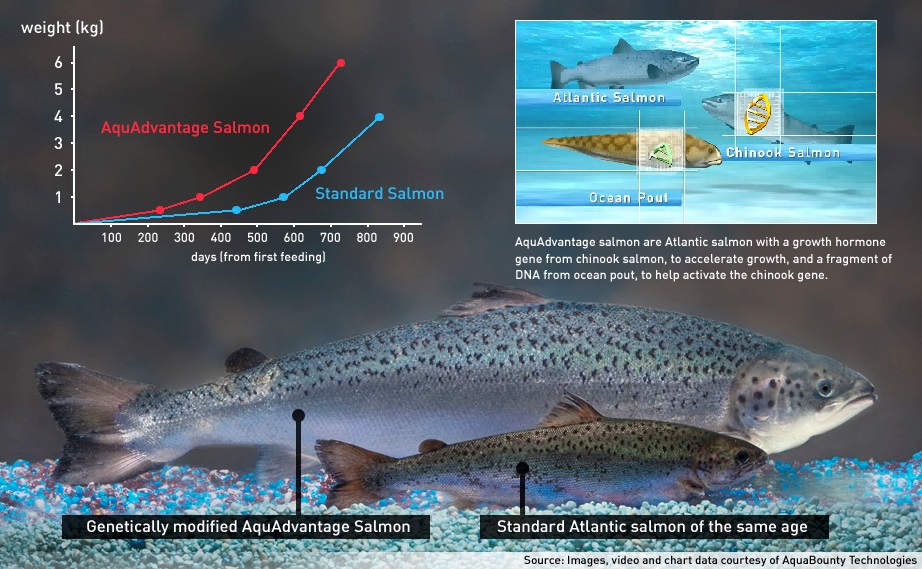
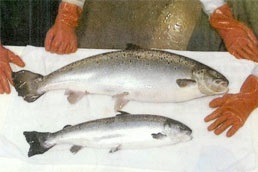
◆初めてのGM動物食品
昨年末、米国FDA(食品医薬品局)は、遺伝子組換え(GM)動物食品としては初めてとなる、成長スピードを早めた鮭について、環境への影響はない、食品としても安全だ、と発表しました。 実は、この評価書がまとめられた日付は5月4日でした。なぜ実際の発表まで半年以上かかったのか、考えられる理由は大統領選挙だと考えられます。オバマ大統領が消費者から嫌われないように、先延ばししたようです。この評価書案は、まもなく正式に承認される予定で、その後GM 鮭が米国内で流通することになります。
このGM鮭は、米国のベンチャ企業が開発したもので、アトランティック・サーモンの成長を促進させたものです。同社は、この鮭は繁殖不能にしてあるため、安全に養殖できると主張してきました。また、魚そのものを販売するのではなく、卵を養殖場に販売することになっています。その養殖場はパナマにあるものを予定しています。
◆性格が獰猛になるなどさまざまな危惧が
しかし、もし不妊の鮭が大量に環境中に逃げ出すと、鮭の滅亡をもたらすかもしれません。また、不妊の技術は絶対とはいえず、生殖能力を回復する可能性が高く、そうなるとGM遺伝子の拡散を招きかねません。 さらには、受精卵を販売することは、当初はパナマだけかもしれませんが、その後、さまざまな場所で養殖されることになり、環境中に逃げ出すリスクを高めることになります。魚を養殖場に完全に封じ込めることなど不可能だからです。 『ニュー・サイエンティスト』誌は、このGM鮭は性格を変え獰猛になることが分かり、もし環境中に逃げ出すと、生態系に大きな影響がでると指摘しました。鮭は肉食であり、ほかの魚を食べるが、この鮭の場合はさらによく食べるため漁業資源が失われたり、稀少種が失われたりする危険があると指摘しています。 米インディアナ州パーデュー大学の研究者らは、雄の生殖能力を抑制したGM魚を放流した時に、環境中に生息する野生種が絶滅に追い こまれる時間は、想定されていたより短くなると述べています。 GM鮭は体が大きく、その分、雌を引きつける能力を高めています。しかし、生命を操作した上に体が大きくなったことから、生殖能力が弱まっています。もし逃げ出したりすると、種の絶滅をもたらすなど生物多様性に与える影響が大きいのです。 スウェーデン・イエテボリ大学の研究でGM魚が環境中に放流された場合、生態系や人間の健康への影響に対する懸念が示されました。理由として、成長が早いと、それだけ環境中の毒素の蓄積が早く、その毒素を人間が摂取したり、成長ホルモンの濃度も高く、それを摂取することによる、がん細胞を刺激するなどの影響も指摘されました。
◆EU議会は輸入禁止を求める
この ようにさまざまな問題点が指摘されていることから、EU議会は欧州委員会に対して、GM鮭の輸入を禁止し、ヨーロッパの市民の食卓に登場しないよう求めました。 米国内でも反対の動きが活発化しています。約30の業界団体で構成されている全米動物農業連盟が、このGM鮭を承認しないよう、米連邦議会に要請書を提出しています。またアラスカ州やカリフォルニア州などの鮭の漁業者を抱える州政府や州議会、そして州選出の連邦議会議員も強く反対しています。
◆国産鮭が減少し養殖鮭の輸入が急増
このGM鮭は、日本の食卓の問題でもあります。現在、日本の食卓に出回る鮭の多くが、輸入ものになってしまいました。このところ国内生産量は減り続け、1996年の37万385トンをピークに、 2010年には19万7900トンになってしまいました。代わりに増え続けたのが輸入鮭で、2010年には24万8674トンにまで増え、国内生産量をかなり上回りました。 輸入先も1990年代までは米国やカナダ産が多かったのですが、いまや半数超をチリ産が占めており、しかも天然ものが激減、大半が養殖ものになってしまいました。 そこに目を付けたのがアクア社である。養殖の主役にこのGM鮭を押し上げようと、開発を進めてきたのです。もし、米国でこの鮭が承認されれば、世界的に流通圧力が強まります。 作物では種子を制するものが作物を支配してきましたが、漁業では受精卵を制するものが魚の世界を制する時代がやってきそうです。
【著者】天笠啓祐 市民バイオテクノロジー情報室代表 (記事はこちら)

The US FDA (Food and Drug Administration) is evaluating the approval of genetically engineered Atlantic Salmon (called AquAdvantage Salmon), which would be raised in the fresh waters of rivers in Chiriquí Province, Panama. See notice in FDA webpage here.
FDA Extends Comment Period on AquAdvantage Salmon Documents
February 13, 2013
“The FDA announced today that it is extending for 60 days the comment period for the draft Environmental Assessment (EA) and preliminary Finding of No Significant Impact (FONSI) pertaining to AquaBounty Technologies’ application for AquAdvantage Salmon. The comment period, originally slated to end on Feb. 25, 2013, now runs until April 26, 2013.
AquAdvantage Salmon are Atlantic salmon that have been genetically engineered to reach a measure of growth commonly used in salmon aquaculture more rapidly than other farmed Atlantic salmon. This is commonly linked to “reaching market size” (about 2-5 kilograms or about 5-12 pounds) in less time than other farmed salmon.
The draft EA and preliminary FONSI are one step in FDA’s evaluation of the AquAdvantage Salmon and do not indicate an approval of the application. The National Environmental Policy Act of 1969 (NEPA) requires FDA and other federal agencies to perform such assessments whenever a major Federal action is taken.”
Quote from FDA’s preliminary FONSI of AquAdvantage Salmon: (in PDF here)
“The Food and Drug Administration’s (FDA’s) Center for Veterinary Medicine (CVM) in support of a New Animal Drug Application (NADA) for a genetically engineered (GE) Atlantic salmon to be produced and grown under specified conditions in physically-contained freshwater culture facilities specified in the sponsor’s application. This line of fish, named AquAdvantage Salmon, is desigend to exhibit a rapid-growth phenotype that allows it to reach smolt size (100g) faster than non-GE farmed Atlantic Salmon.
“Under the conditions proposed for the NADA, AquAdvantage Salmon would be produced as triploid, all-female populations with eyed-eggs as the product for commercial sale and distribution. These eggs would be produced in the sponsor’s facility on Prince Edward Island (PEI) in Canada. After confirming the genetic integrity of the broodstock used for manufacture and effective induction of triploidy in the eyed-eggs, these eggs would be shipped to a land-based grow-out facility in the highlands of Panama, where they would be reared to market size and harvested for processing.”

 Mitsui Engineering & Shipbuilding Co., Ltd. (MES) completed and delivered a 174,600 dwt type bulk carrier, MV “NEW EXPEDITION” at its Chiba Works on February 1st, 2013 to Salute Maritime S.A., Panama.
Mitsui Engineering & Shipbuilding Co., Ltd. (MES) completed and delivered a 174,600 dwt type bulk carrier, MV “NEW EXPEDITION” at its Chiba Works on February 1st, 2013 to Salute Maritime S.A., Panama.








